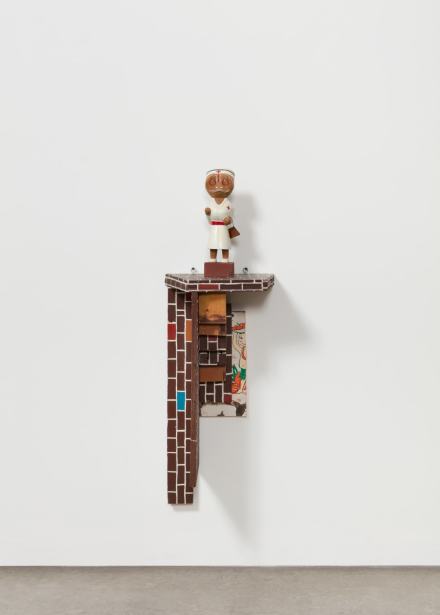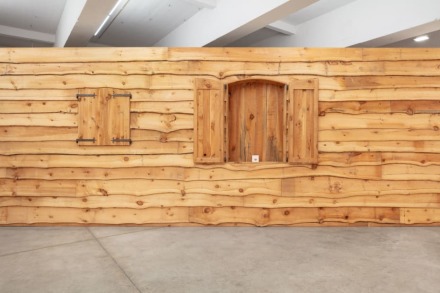
Haim Steinbach, Display #28 – Rustic Wall (1991), via Tanya Bonakdar
For more than four decades, artist Haim Steinbach has explored the psychological, aesthetic, and cultural aspects of collecting and arranging found objects, selecting items that range from the obscure to the ordinary, the private to the ethnographic and using them as a meditative element to emphasize notions of circulation and human connection. For his most recent show at Tanya Bonakdar in New York, a selection of works on view highlights a concentrated three-year period in the artist’s career, and offers a recontextualization of his own historic practice and an occasion for reflection.
Comprising a seminal large-scale “display†and objects from the same time period, the exhibition is populated by individuals who are both named and unnamed, touching upon family gatherings and traditions, intimacy, and the personifying power objects can hold. At the center of the exhibition is Display #28 (rustic wall with music box and candle snuffer) (1991), an architectural façade that spans nearly the entire diagonal axis of the gallery’s main space. The concept of “display†recurs throughout Steinbach’s practice as a form that foregrounds objects, drawing awareness to the means of presentation and its implications.

Haim Steinbach, Untitled (Table with Towels, Bone, Pacifier) (1993), via Tanya Bonakdar
Inspired by a farmhouse in Tuscany where Steinbach stayed in the summer of 1991, the work includes found objects from the original site that span several decades and cultural epochs to create a densely layered network of timeframes and meanings.

Haim Steinbach, Shelf with Nurse (1983), via Tanya Bonakdar
In the adjacent gallery, Untitled (table with towels, bone, pacifier) (1993) a broad glass, wood and MDF table presents a selection of folded cotton towels collected from an array of hotels in Austria. Embroidered and embossed with their owners’ company insignia, the towels are closely tied to both known places and unknown bodies, referencing both physical sites and the absent bodies that have at one point touched and interacted with these objects. Steinbach manages to emphasize both static locales and mobile networks of humans simultaneously, underscoring both sides of the travel industry as a complex of movements and actors. On the surrounding walls are three wooden boxes with white plastic-laminated fronts: Untitled (box with handkerchief – Bess) (1993), Untitled (box with handkerchief – Adi) (1993), and Untitled (box with handkerchiefs – Hector/Michelle) (1993). The boxes recall both minimalist sculpture as well as painting. Each work features a pull-out drawer that houses a square-folded white handkerchief embroidered with a name, a trace of human presence, proximity and connection as well as historical memory.

Haim Steinbach, Display #28 – Rustic Wall (1991), via Tanya Bonakdar
This range of works here, unified from several exhibitions yet presented here together, underscores a recollection that both underscores Steinbach’s memory of his works, and the varied physical spaces and materials that his work originally drew from, underscoring the nuances and interconnected meanings that spring from the endgame of postmodernism.
The show closes February 27th, 2021.
– J. Shine
Read more:
Haim Steinbach [Exhibition Site]



